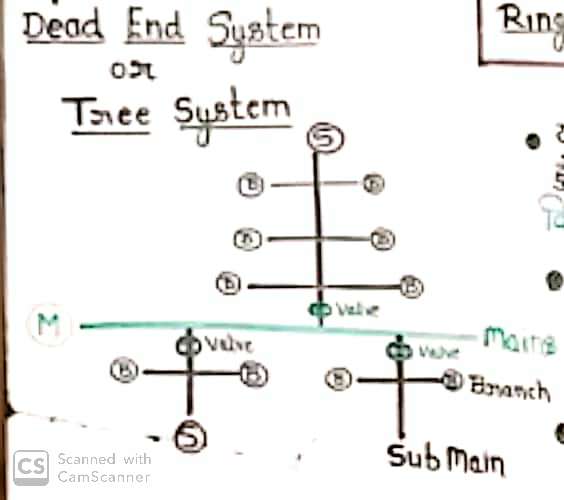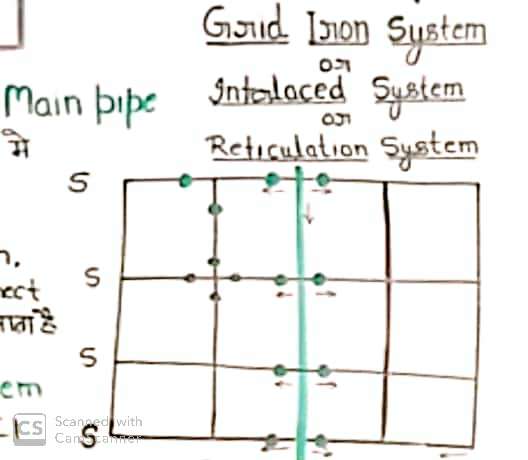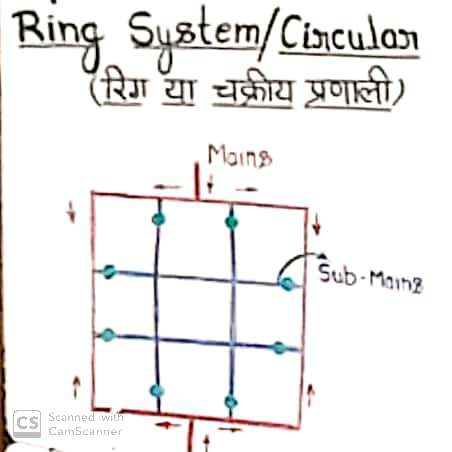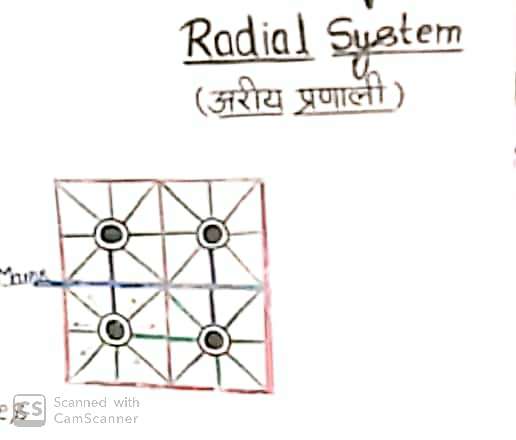Contents
What is the Water Distribution System?
Water Distribution System is, Where Water is stored or collected in the reservoir. This stored water is treated in the reservoir itself. After the treatment process is done this treated water is to be transferred from the storage reservoir to colonies or cities. To transfer this water from location ‘A’ to location ‘B’ we need a source via which this water will be delivered. This source is known as the water distribution system.
Types Of Water Distribution System
- Dead End System or Tree System.
- Grid Iron System or Interlaced System or Reticulation System.
- Ring System.
- Radial System or Star System.
1. Dead End System or Tree System

In this type of system, the flow is Unidirectional. This type of system is generally used in old cities or old settlements. The cities which are unplanned are best suited for this type of distribution system.
The name tree system is given because of its structure. It has one mainline which is connected with Sub mainline which are further connected with Branch pipelines and finally these branch pipes are connected with lateral pipes from which the water is distributed to the consumer.
It has Unidirectional water flow as starting from the reservoir the mainline is laid. So one end is the dead-end which is the reservoir. As the flow is Unidirectional you will always face problems like less pressure and less amount of discharge at the endpoints. This problem will always be there still you increase the pressure at the starting point because there is only one mainline from which the water is distributed to all the locations.
Disadvantages of Dead end system or Tree System
- In case of emergency or fire condition in the area which is far from the main supply line at that location also the pressure you get is very low which is not sufficient for controlling the fire condition.
- As this system has multiple numbers of dead ends, if suppose at any dead-end like lateral pipe end any leakage occurs then there are chances are very high that this treated water can get Recontaminated which is the biggest problem in this type of system.
CivilQuery
2. Grid Iron System or Interlaced System or Reticulation System.

In this type of system, pipes are laid in a grid.
The flow is not Unidirectional the flow is in multiple directions as it is laid in the grid. This type of system is generally used in new cities or new settlements. The cities which are well planned are best suited for this type of distribution system. This is the improved way of the Dead End System or Tree System.
In the well-planned cities the mainline is laid in the center of the city or town which is further connected with Branch pipes. These branch pipes are interconnected as it is a grid. In this system the diameter of pipes in more as compared to the dead-end system or tree system.
If the city is spread in a big stretched area still this system works nicely. As the water reach one location there is no fixed route as it is grid water takes multiple routes to reach one location so the pressure at all points in the city is maintained. At every crossing point, a sluice valve is provided to maintain the flow. In this system, more number of sluice values are required.
Advantages
- In case of emergency or fire condition in the area which is far from the main supply line or nearby at that location the pressure you get is very high which is sufficient for controlling the fire condition.
- As this system has no dead ends there is no chance of leakages, so no chance of getting this treated water Recontaminated which is the biggest advantage of this type of system.
3. Ring System.

In this type of water distribution system mainline is laid on the outer periphery of the city or the targeted area. To this mainline grid type branch pipes are connected. The water flows from the circumference towards the center of the targeted area. In this system, there are no dead ends as it is a grid and the pipes are interconnected.
This type of system is used in well-planned cities. This system cannot be used in unevenly developed cities. As pipes laid in a grid so the water pressure is very high at all the points.
If the city is spread in a big stretched area still this system works nicely. As the water reaches one location there is no fixed route as it is grid water takes multiple routes to reach one location so the pressure at all points in the city is maintained.
Advantages
- In any emergency conditions like fire, condition water is available at high pressure at the required point.
- As this system has no dead ends there is no chance of leakages, so no chance of getting this treated water Recontaminated which is the biggest advantage of this type of system like the Grid Iron System or Interlaced System or Reticulation System.
4. Radial System or Star System.

In this type of water distribution system, water moves from center to circumference. This is just the opposite of the Ring System. This system is also known as the star system as the area is divided into different zones. In this, the mainline is laid in the center of the city or town. The city is divided into different zones, in each zone, the water reservoir or overhead water tank is provided. These overhead tanks get water from the mainline. Then water is transferred to the consumer from these overhead tanks.
This system can be provided in those cities where the roads are radially in position as the pipes are transferred along the roads. As there are no dead ends in this system so the pressure is maintained in all the locations in the city.
In case if there is any problem in any of the reservoir or overhead water tank then water can be diverted from other tanks as the pipes are also transferred from the circumference of the city or town.
Advantages
- In case of emergency or fire conditions in the area, which is far from the main supply line or nearby at that location the pressure you get is very high. which is sufficient for controlling the fire condition.
- As this system has no dead ends there is no chance of leakages, so no chance of getting this treated water Recontaminated which is the biggest advantage of this type of system like the Grid Iron System or Interlaced System or Reticulation System and Ring System.

